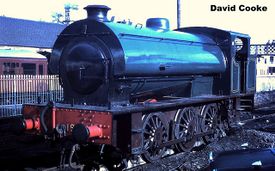WD 193 Shropshire
| WD 193 Shropshire | |
|---|---|
 WD 193 in Bridgnorth Yard in 1972 (David Cooke) | |
| Built By | Hunslet Engine Company |
| Configuration | 0-6-0ST |
| Status | Out of service |
| Loco Number | WD 193 |
| Other Numbers | Works Number 3793 |
| History | |
| Built | 1953 |
| Designed By | Hunslet Engine Company |
| Type | WD Austerity |
| 1971 | Arrived on SVR |
| 1981 | Sold by the SVR |
| 1984 | Left the SVR on loan |
| Technical | |
| Length | 30ft 4" |
| Weight | 48t 5cwt |
| Tractive effort | 23.870 lb |
| Pressure | 170 lb/sq in |
WD 193 'Shropshire' was resident on the SVR between 1971 and 1981.
The War Department Austerity 0-6-0ST was the standard World War II shunting engine, designed by the Hunslet Engine Company in Leeds and built between 1942 and 1946 to the requirements of the Ministry of Supply. A number of these engines were also built by sub-contractors, an example of which is temporary SVR resident WD 71516 Welsh Guardsman. 75 were taken into LNER stock as J94 class and on nationalisation were given a 4F classification. The design continued to be built into the 1950s for industrial users, including the National Coal Board.
Contents
WD 193 in service
This locomotive was built by Hunslet in 1953 as Works Number 3793 and formed part of a further batch ordered for WD (Army) use, for which it was allocated the number WD 193. WD 193 was initially put into store at Bicester in July 1953, but by 1955 it had moved to the WD-operated Shropshire & Montgomeryshire Light Railway based at Kinnerley, where it saw intermittent use. On 20 March 1960 WD 193 worked a special last train over the S & M organised by the Stephenson Locomotive Society, before moving to the Arncott workshops at Bicester in June 1960. During the 1960s 193 was kept at the Long Marston Depot, mainly in store.[1]
WD 193 in preservation
After being declared surplus to requirements by the MOD, WD 193 was bought in June 1971 for use on the SVR. Following a re-paint into a dark green livery while still at Long Marston, 193 was moved to the SVR, arriving on 7 August 1971.[1] The locomotive was in almost good mechanical order but was initially beset by priming due to the grease used to preserve the boiler. The opportunity was taken to equip the locomotive for steam heating so that it could be used on winter services.[2]
With the SVR only operating between Bridgnorth and Hampton Loade, WD 193 initially saw regular service, with 5 carriages being a typical load. On the weekend of 23-24 December 1973, WD 193 hauled the SVR's first "Santa Claus" specials; reduced to 3 carriages and using steam heating. The first Boxing Day service also took place in that year.[3]
Following the opening to Bewdley in 1974, WD 193’s limited water capacity became a factor. It was used mainly on the Hampton Loade "shuttles" and lightly loaded mid-week trains, serving as a standby locomotive for full line services between Bridgnorth and Bewdley.[4] In winter 1974-75 it was kept serviceable for works trains and for the Christmas services, which it again worked single-handed. During the winter a new point was installed at the southern end of Bridgnorth yard, on which WD 193 was promptly derailed on the first day of the 1975 season![5]
In 1978 WD 193 was repainted into an LMS-style crimson lake livery, and given the name 'Shropshire' at a naming ceremony on 15 April 1978.[6]
Mileage on the SVR
Mileages for 193 as reported in SVR News 152 “SVR Steam Locomotive Mileages 1969-1989” were as follows:
| Year | Mileage | Notes |
|---|---|---|
| 1967-1970 | 1,021 | Note 1 |
| 1971 | 88 | |
| 1972 | 701 | |
| 1973 | 900 | |
| 1974 | 1,830 | |
| 1975 | 1,905 | |
| 1976 | 960 | |
| 1977 | 950 | |
| 1978 | 770 | |
| 1979 | 1935 | Note 2 |
| 1980 | 435 | |
| 1981 | 160 | |
| Total | 11,655 |
Note 1: Also reported in SVR News 58 "Steam Locomotive Mileages for the Decade", although SVR News and Stock Books confirm that the locomotive only arrived in 1971.
Note 2: Originally reported in SVR News 58 as 335 miles.
Move from the SVR
In 1981 WD 193 was lent to the 6000 Locomotive Association who were based at the Bulmers Railway Centre at Hereford. The locomotive traveled there in steam on 30 January 1981 in convoy with 4930 Hagley Hall and ‘Black 5’ LMS 5000 which were setting off on main line duties.[7] The move to Hereford eventually became permanent, with the SVR Board announcing in late 1983 that WD 193 was being sold.
From 1999 WD 193 was based at the Ribble Steam Railway in Preston.[8]
Gallery
See also
References
Links
- Ribble Steam Railway page for WD 193 Retrieved 29 July 2018.
- Hunslet Austerity 0-6-0ST on Wikipedia
| ||||||||||||||||||||||||||||||||||



